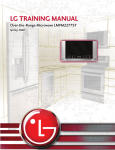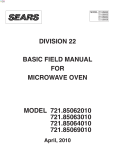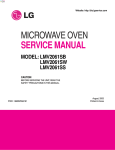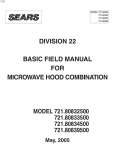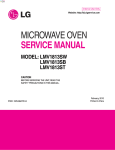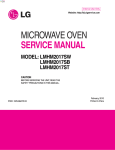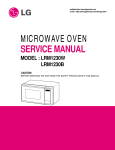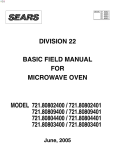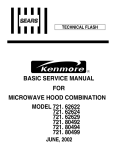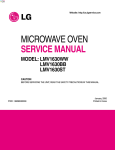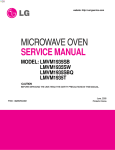Download Sears 721.88509800 Specifications
Transcript
삼 정 흥 판 MODEL 721.88502 721.88503 721.88509 DIVISION 22 BASIC FIELD MANUAL FOR MICROWAVE HOOD COMBINATION MODEL 721.88502800 721.88503800 721.88509800 June, 2008 CAUTION WARNING TO SERVICE TECHNICIANS PRECAUTIONS TO BE OBSERVED BEFORE AND DURING SERVICING TO AVOID POSSIBLE EXPOSURE TO EXCESSIVE MICROWAVE ENERGY a. Do not operate or allow the oven to be operated with the door open. b. Make the following safety checks on all ovens to be serviced before activating the magnetron or other microwave source, and make repairs as necessary; (1) Interlock operation, (2) proper door closing, (3) seal and sealing surfaces (arcing, wear, and other damage), (4) damage to or loosening of hinges and latches, (5) evidence of dropping or abuse. c. Before turning on microwave power for any service test or inspection within the microwave generating compartments, check the magnetron, wave guide or transmission line, and cavity for proper alignment, integrity, and connections. d. Any defective or misadjusted components in the interlock, monitor, door seal, and microwave generation and transmission systems shall be repaired, replaced, or adjusted by procedures described in this manual before the oven is released to the owner. e. A Microwave leakage check to verify compliance with the Federal performance standard should be performed on each oven prior to release to the owner. • Proper operation of the microwave ovens requires that the magnetron be assembled to the wave guide and cavity.Never operate the magnetron unless it is properly installed. • Be sure that the magnetron gasket is properly installed around the dome of the tube whenever installing the magnetron. • Routine service safety procedures should be exercised at all times. • Untrained personnel should not attempt service without a thorough review of the test procedures and safety information contained in this manual. FOREWORD Read this Manual carefully. Failure to adhere to or observe the information in this Manual may result in exposing yourself to the Microwave Energy normally contained within the oven cavity. MODEL 721.88502800 721.88503800 721.88509800 TABLE OF CONTENTS (Page) SAFETY PRECAUTIONS ..................................................................................................................Inside front page SPECIFICATIONS ..................................................................................................................................................1-1 CAUTIONS ..............................................................................................................................................................2-1 INSTALLATIONS .. ..................................................................................................................................................3-1 OPERATING INSTRUCTIONS ........ .......................................................................................................................4-1 CONTROL PANEL ..........................................................................................................................................4-1 CONTROL PANEL INSTRUCTIONS ..............................................................................................................4-2 OVERALL CIRCUIT DIAGRAM ..............................................................................................................................5-1 SCHEMATIC DIAGRAM .................................................................................................................................5-1 MATRIX CIRCUIT FOR TOUCH KEY BOARD ..............................................................................................5-2 GENERAL INFORMATION FOR SERVICE ...........................................................................................................6-1 GENERAL PRECAUTIONS IN USE ...............................................................................................................6-1 TRIAL OPERATION ........................................................................................................................................6-1 FEATURES AND SPECIFICATIONS FEATURES .........................................................................................6-1 SERVICE INFORMATION ......................................................................................................................................7-1 PRECAUTIONS AND REPAIR SERVICE TIPS .............................................................................................7-1 MICROWAVE LEAKAGE TEST .....................................................................................................................7-2 POWER OUTPUT MEASUREMENT ..............................................................................................................7-3 DISASSEMBLY INSTRUCTIONS ...................................................................................................................7-4 INTERLOCK SYSTEM ..................................................................................................................................7-12 INTERLOCK CONTINUITY TEST ................................................................................................................7-14 TEST AND CHECKOUT PROCEDURES AND TROUBLESHOOTING .......................................................7-15 A.TEST PROCEDURES ........................................................................................................................7-15 B.CHECKOUT PROCEDURES .............................................................................................................7-19 C.TROUBLESHOOTING .......................................................................................................................7-22 EXPLODED VIEW ..................................................................................................................................................8-1 PART REFERENCE LIST .......................................................................................................................................9-1 MINI MANUAL (TECH SHEET) .......................................................................................................................................10-1 SPECIFICATIONS Rated Power Consumption ................................1750W maximum (Microwave oven+Cook top lamps+Ventilation fan) Microwave Output ...............................................1100W (IEC60705) Frequency ..........................................................2,450 MHz ±50 MHz Power Supply .....................................................120 VAC, 60 Hz Rated Current ....................................................14.5 Amp. (Microwave oven+Cook top lamps+Ventilation fan) Magnetron Cooling .............................................Forced Air Cooling Rectification .......................................................Rectification Voltage Double Half-Wave Door Sealing ......................................................Choke System Safety Devices ...................................................Magnetron Thermostat: Open at 293℉ (145℃) ± 41℉ (5℃) Close at 140℉ (60℃) ± 41℉ (5℃) ............................................................................Oven Thermostat: Open at 230℉ (110℃) ± 41℉ (5℃) Close at 32℉ (0℃) ± 41℉ (5℃) ............................................................................Fuse(20A) ............................................................................Primary Interlock Switch ............................................................................Secondary Interlock Switch ............................................................................Interlock Monitor Switch Magnetron ..........................................................2M282J (Toshiba) Cook top Lamp ...................................................120 V, 20 W (Halogen) Cavity Lamp .......................................................120 V, 20 W (Halogen) Timer ..................................................................Digital,up to 99 min.(in each cooking stage) Tray ....................................................................Tempered Safety Glass Overall Dimensions ............................................2915/16”(W)x167/16”(H)x153/8”(D) Oven Cavity Size ...............................................227/8”(W)x101/4”(H)x141/2”(D) Effective Capacity of Oven Cavity ......................2.0 Cu.ft. Accessories ........................................................Owner ’s Manual &Cooking Guide, Installation Manual, ............................................................................Exhaust Adapter, Exhaust Damper, Mounting Kit and Filter, ............................................................................Rotating Ring Assembly, Glass Tray, Metal Rack, Guide Tray. SWITCH CHART SWITCH MODE CONDITIONS DOOR OPEN DOOR CLOSED PRIMARY INTERLOCK SWITCH SECONDARY INTERLOCK SWITCH INTERLOCK MONITOR SWITCH COM NO OPEN CLOSE COM NO OPEN CLOSE COM NC CLOSE OPEN NOTE: Use the above switch chart with circuit diagram on page 5-1. 1-1 CAUTIONS Unlike other appliances,the microwave oven is high-voltage and high-current equipment. Though it is free from danger in ordinary use, extreme care should be taken during repair. MICROWAVE RADIATION Personnel should not be exposed to the microwave energy which may radiate from the magnetron or other microwave generating device if it is improperly used or connection. All input and output microwave connections, waveguide,flange,and gasket must be secure never operate the device without a microwave energy absorbing load attached. Never look into an open waveguide or antenna while the device is energized. • DO NOT operate on a 2-wire extension cord during repair and use. • NEVER TOUCH any oven components or wiring during operation. • BEFORE TOUCHING any parts of the oven, always remove the power plug from the outlet. • Remove your watches whenever working close to or replacing the Magnetron. • DO NOT touch any parts of the control panel circuit. A resulting static electric discharge may damage this P.C.B. • NEVER operate the oven with no load. • NEVER injure the door seal and front plate of the oven cavity. • NEVER put iron tools on the magnetron. • NEVER put anything into the latch hole and the interlock switches area. • Proper operation of the microwave oven requires that the magnetron be assembled to the waveguide and cavity. Never operate the magnetron unless it is properly installed. • Be sure that the magnetron gasket is properly installed around the dome of the tube whenever installing the magnetron. THE OVEN IS TO BE SERVICED ONLY BY PROPERLY QUALIFIED SERVICE PERSONNEL. 2-1 INSTALLATIONS BEFORE YOU BEGIN, READ THE FOLLOWING INSTRUCTIONS COMPLETELY AND CAREFULLY. PRECAUTIONS ON INSTALLATION A. Plug the power supply cord into a 120V AC, 60Hz, single-phase power source with a capacity of at least 20 amperes. B. Avoid placing the unit in a location where there is direct heat or splashing water. C. Install the unit on the mounting plate firmly. D. Place the unit as far away as possible from TV, radio, etc. to prevent interference. GROUNDING INSTRUCTIONS For personal safety, this appliance must be fully grounded at all times. In the event of an electrical short circuit, grounding reduces the risk of electrical shock. The plug must be plugged into an outlet that is properly installed and grounded. CAUTION This unit is equipped with a 3-prong plug for your safety.If the wall outlet is a grounded 3-hole type, the unit will be grounded automatically. WARNING Improper use of the grounding plug can result in a risk of electric shock. Do not, under any circumstances, cut or remove the third ground prong from the power cord plug. 3-1 OPERATING INSTRUCTIONS CONTROL PANEL 1 3 2 4 5 6 8 7 9 11 12 10 14 13 15 16 17 19 20 18 4-1 CONTROL PANEL INSTRUCTIONS 1. Display Screen shows the time of day and cook mode when the microwave oven is not in use. During programming, it displays function menus for you to choose from, servings and weights for you to enter, preparation instructions, and cooking time/power settings for you to select. During a cooking cycle, it counts down the remaining time and prompts you to stir, turn food, etc., as necessary. 9. SOFTEN. Touch this pad to soften Butter, Cream Cheese, Frozen Juice, Ice Cream. MELT. Touch this pad to melt Butter, Cheese, Chocolate, Marshmallows. 10. ADD 30 SEC. Touch this pad to cook for 30 seconds at 100%cook power, or to add extra seconds at the set cook power to your cooking cycle. 11. FAVORITES. Press this pad to add, edit or remove a recipe from the memory. 2. POPCORN. Touch this pad to pop popcorn with the sensor feature. The oven’s sensor will tell the oven how ong to cook depending on the amount of humidity it detects from the popcorn. 12. COOK TIME. Touch this pad to to set a cooking time. 13. CLOCK. Touch this pad to set the time of day. 3. COOK. Touch this pad to cook Casserole, Eggs, Fish & Seafood, Frozen Entree, Meat, Pizza-Microwave. Potatoes, Poultry, Rice & Pasta, Vegetable-Canned, Vegetable-Fresh, Vegetable-Frozen. The oven’s sensor will tell the oven how long to cook depending on the amount of humidity coming from the food. 14. KITCHEN TIMER. Touch this pad to set the kitchen timer. 15. OPTIONS. Touch this pad to set auto night light, clock on/off, demo on/off, LBS/KG, reminder scroll speed sound on/off 4. REHEAT. Touch this pad to reheat Beverage, Casserole, Dinner Plate, Pizza Reheat, Soup & Sauce. The oven’s sensor will tell the oven how long to cook depending on the amount of humidity coming from the food. 16. START. Touch this pad to start a function. If you open the door after the oven begins to cook, retouch start. 5. Touch DIAL Control. Use this dial to select oven functions, such as quantities of food and cooking times/powers. 18. VENT ON/OFF. Touch this pad to turn the fan on or off. 17. STOP/CLEAR. Touch this pad to pause and cancel any cooking function. 19. VENT 5-SPEED. Touch this pad to choose one of 5 fan speeds. 6. BACK. Press this pad to step back one or more levels in the program process. 20. LIGHT HIGH/NIGHT/OFF. Touch this pad to turn on the cooktop light. 7. AUTO DEFROST. Touch this pad to defrost food by entering weight, cook time. 8. EXPRESS DEFROST. Touch this pad to defrost 1 lb meet Quickly. 4-2 OVERALL CIRCUIT DIAGRAM SCHEMATIC DIAGRAM 5-1 MATRIX CIRCUIT FOR TOUCH KEY BOARD 5-2 GENERAL INFORMATION FOR SERVICE GENERAL PRECAUTIONS IN USE FEATURES AND SPECIFICATIONS FEATURES A. Never operate the unit when it is empty. Operating the oven with no load may shorten the life of the magnetron. Whenever cooking dry foods (dried fish, bread, etc.) or a small amount of food, be sure to put a glass of water into the cooking compartment. The glass turntable may become hot after operating, be careful when touching it. B. Aluminum foil should be avoided because it will disrupt cooking and may cause arcing. However, small pieces may be used to cover some parts of food to slow the cooking. Any aluminum foil used should never be closer than 2.5 cm to any side wall of the oven. A. The safety systems incorporated in this model are: (1) Primary interlock switch (2) Secondary interlock switch (3) Interlock monitor switch (4) Choke system (5) Oven cavity thermostat (Note: This thermostat located on the oven cavity will open and stop the unit from operation only if a high temperature is reached, such as, a fire created by overcooking food.) B. Any one of 10 power output levels ranging 0W to 1100W can be selected by the touch control and electronic computer system. TRIAL OPERATION After installation, the following sequences and results should be checked carefully. A. Put a container filled with water (about 1 liter)into the oven, and close the door tightly. B. Set cooking time for 10 minutes. C. Press DIAL to start. Make sure the cavity light comes on. The unit will begin cooking and the display window will show the time counting down by seconds. D. After about 5 minutes, make sure the primary interlock switch, the secondary interlock switch and the interlock monitor switch operate properly by opening and closing the door several times. Press the DIAL key each time the door is closed. E. Continue operating the unit. For long beep sound signal is heard when the time is up. The unit will shut off automatically. F. Confirm the water is hot. G. Finally, measure the output power according to “POWER OUTPUT MEASUREMENT ” on page 7-3. 6-1 SERVICE INFORMATION PRECAUTIONS AND REPAIR SERVICE TIPS (3) Do not operate the unit until it is completely repaired, if any of the following conditions exist. The unit must not be operated. (a) The door does not close firmly. (b) The hinge is broken. (c) The door seal is damaged. (d) The door is bent or warped, or there is any other visible damage on the unit that may cause microwave energy leakage. NOTE: Always keep the seal clean. (e) Make sure that there are no defective parts in the interlock mechanism. (f) Make sure that there are no detective parts in the microwave generating and transmission assembly (especially waveguide). PRELIMINARY A. SINCE NEARLY 4000 VOLTS EXISTS IN SOME CIRCUITS OF THIS UNIT REPAIRS SHOULD BE CARRIED OUT WITH GREAT CARE. The filament leads of magnetron carry High Voltage with respect to ground. Extreme caution must be exercised. Never plug the unit into a power source to determine which component is defective in high voltage section. B. TO AVOID POSSIBLE EXPOSURE TO MICROWAVE ENERGY LEAKAGE, THE FOLLOWING PRECAUTIONS MUST BE TAKEN BEFORE SERVICING. (4) The following items should be checked after the unit is repaired: (a) The interlock monitor switch is connected correctly and firmly. (b) The magnetron gasket is properly positioned and mounted. (c) The waveguide and the oven cavity are intact. (no microwave energy leakage) (d) The door can be properly closed and the safety switches work properly. (e) The unit must stop when the door is opened or the time is up. (1) Before the power is applied: (a) Make sure the primary interlock switch, the secondary interlock switch and the interlock monitor switch operate properly by opening and closing the door several by opening and closing the door several times. (b) Make sure the perforated screen and the dielectric choke of the door are correctly and firmly mounted. (2) After power is applied: (a) Make sure the interlock switch mechanism is operating properly by opening and closing the door. The unit must not be operated with any of the above components removed or by-passed. (b) Check microwave energy leakage must be below the limit of 5 mW/cm2 . (All service adjustments should be made for minimum microwave energy leakage readings). 7-1 MICROWAVE LEAKAGE TEST CAUTIONS EQUIPMENT- • Be sure to check microwave leakage prior to servicing the oven if the oven is operative prior to servicing. • The service personnel should inform the manufacture importer, or assembler of any certified oven unit found to have a microwave emission level in excess of 5 mW/cm2 and should repair any unit found to have excessive emission levels at no cost to the owner and should ascertain the cause of the excessive leakage. The service personnel should instruct the owner not to use the unit until the oven has been brought into compliance. • If the oven operates with the door open, the service personnel should; - Tell the user not to operate the oven - Contact the manufacturer and CDRH (Center for Devices and Radiological Health) immediately. NOTE: Address on CDRH Office of Compliance (HFZ-312) Center for Devices and Radiological Health 1390 Piccard Drive Rockville, Maryland 20850 • The service personnel should check all surface and vent openings for microwave emission testing. • Check for microwave energy leakage after every servicing. The power density of the microwave radiation leakage emitted by the microwave oven should not exceed 1mW/cm.sq. And always start measuring of an unknown field to assure safety for operating personnel from radiation leakage. NOTE: The standard is 5mW/cm.sq. while in the customer’s home. 1mW/cm.sq.stated here is manufacturer’s own voluntary standard for units in customer’s home. • TESTER (VOLTS-DC, AC, Ohmmeter) • Microwave survey meter - Holaday HI-1500 HI-1501 - Narda 8100 8200 • 600 cc non conductive material beaker (glass or plastic), inside diameter:approx. 8.5 cm (3 1/2 in.) • Glass thermometer: 100 °C or 212°F (1 deg scale) MEASURING MICROWAVE ENERGY LEAKAGE • Pour 275±15cc of 20±5°C(68±9°F) water in a beaker which is graduated to 600 cc, and place the beaker on the oven. • Set the energy leakage monitor to 2450 MHz and use it following the manufacturer's recommended test procedure to assure correct result. • When measuring the leakage, always use the 2-inch (5cm) spacer supplied with the probe. • Operate the oven at its maximum output. • Measure the microwave radiation using and electromagnetic radiation monitor by holding the probe perpendicular to the surface being measured. Move probe along shaded area. Probe scanning speed Less than 2.5 cm/sec. ( 1 in/sec) 7-2 MEASUREMENT WITH THE OUTER CASE REMOVED NOTE WHEN MEASURING (1) Do not exceed meter full scale deflection. (2) The test probe must be removed no faster than 1 inch/sec (2.5cm/sec) along the shaded area, otherwise a false reading may result. (3) The test probe must be held with the grip portion of the handle. A false reading may result if the operator’s hand is between the handle and the probe. (4) When testing near a corner of the door, keep the probe perpendicular to the surface making sure the probe horizontally along the oven surface, this may possibly cause probe damage. (1) When you replace the magnetron, measure for microwave energy leakage before the outer case is installed and after all necessary components are replaced or adjusted. Special care should be taken in measuring the following parts. -Around the magnetron -The waveguide WARNING: AVOID CONTACTING ANY HIGH VOLTAGE PARTS. MEASUREMENT WITH A FULLY ASSEMBLED OVEN RECORD KEEPING AND NOTIFICATION AFTER MEASUREMENT (1) After all components, including the outer panels, are fully assembled, measure for microwave energy leakage around the door viewing window, the exhaust opening and air inlet openings. (2) Microwave energy leakage must not exceed the values prescribed below. NOTES: Leakage with the outer panels removed -less than 5 mW/cm2. Leakage for a fully assembled oven (“Before the latch switch (primary) is interrupted”) with the door in a slightly opened position - less than 1 mW/cm2 (1) After adjustment and repair of any microwave energy interruption or microwave energy blocking device, record the measured values for future reference. Also enter the information on the service invoice. (2) Should the microwave energy leakage not be more than 1 mW/cm2 after determining that all parts are in good condition, functioning properly and genuine replacement parts which are listed in this manual have been used. (3) At least once a year, have the electromagnetic energy leakage monitor checked for calibration by its manufacturer. POWER OUTPUT MEASUREMENT (1) Microwave power output measurement is made with the microwave oven supplied at its rated voltage and operated at its maximum microwave power setting with a load of (1000±5) g of potable water. (2) The water is contained in a cylindrical borosilicate glass vessel having a maximum material thickness of 1/8 ” (3 mm) and an outside diameter of approximately 7.6 ” (190mm). (3) The oven and the empty vessel are at ambient Temperature(T0) prior to the start of the test. (4) The initial temperature (T1)of the water is (10 ±1)°C (50°F) It is measured immediately before the water is added to the vessel. After addition of the water to the vessel, the load is immediately placed on the center of the turntable which is in the lowest position and the microwave power switched on. (5) The time t for the temperature of the water to rise by a value T of (10 ±1)°K is measured,where t is the time in seconds and T is the temperature rise. The initial and final water temperatures are selected so that the maximum difference between the final water temperature and the ambient temperature is 5 °K. (6) The microwave power output P in watts is calculated from the following formula : 4,187 Mw(T2 –T1)+0.55Mc(T2 –T0) t is measured while the microwave generator is operating at full power. Magnetron filament heat-up time is not included.(about 3 sec) (7) The water is stirred to equalize temperature throughout the vessel, prior to measuring the final water temperature. (8) Stirring devices and measuring instruments are selected in order to minimize addition or removal of heat. P= Where P is the microwave power output,in watts: Mw is the mass of the water,in grams: Mc is the mass of the container,in grams: T0 is the ambient temperature,in °C: T1 is the initial temperature of the water,in °C: T2 is the final temperature of the water,in °C: t is the heating time in seconds,excluding the magnetron filament heat-up time. 7-3 DISASSEMBLY INSTRUCTIONS (4) Remove 3 screws securing the circuit board. IMPORTANT NOTES: UNIT MUST BE DISCONNECTED FROM ELECTRICAL OUTLET WHEN MAKING REPAIRS, REPLACEMENTS, ADJUSTMENTS AND CONTINUITY CHECKS. WHEN RECONNECTING THE WIRE LEADS TO ANY PART, MAKE SURE THE WIRING CONNECTIONS AND LEAD COLORS ARE CORRECTLY MATCHED ACCORDING TO THE OVERALL CIRCUIT DIAGRAM. (ESPECIALLY SWITCHES AND HIGH VOLTAGE CIRCUIT.) Circuit Board A. REMOVING POWER AND CONTROL CIRCUIT BOARD (Figures 1, 2 and 3) (1) Remove a screw securing the control panel assembly to the oven cavity. (2) Remove the control panel with pushing it upward. (3) Remove the connectors, and sensor, wire leads, from the circuit board. Control Panel Figure 2 Screw (5) Remove the FPC connector from the terminal socket following “HOW TO REMOVE THE FPC CONNECTOR ” on the next page.. (6) Remove the circuit board from the control bracket carefully. Circuit Board (CN7) Control Bracket (CN8) FPC Connector(S1) (RY15) (RY10) Circuit Board (CN4) (CN2) Figure 1 Figure 3 7-4 HOW TO REMOVE THE F.P.C. CONNECTOR HOW TO INSERT THE F.P.C. CONNECTOR Follow the steps below as illustrated in Figures 4 and 5 to remove the F.P.C. connector. Follow the steps below as illustrated in Figures 6 and 7 to insert the F.P.C. connector. (1) Insert the F.P.C. connector into the terminal socket securely with the fingers. (2) Hold the plastic fastener with thumb and forefinger of the other hand, and push it slowly into the terminal socket. (Figure 6) NOTE: When reconnecting the F.P.C connector make sure that the holes on the F.P.C. connector are properly engaged with the hooks on the plastic fastener (3) Lock the level of the plastic fastener into the hook of the terminal socket securely by releasing the fingers. (Figure 7) (1) Hold the edges of the plastic fastener with thumb and forefinger. (Figure 4) (2) Lift up the lever of the plastic fastener from the terminal socket by lightly pressing the lever end with forefinger. (Figure 5) (3) Remove the F.P.C. connector from the terminal socket. 7-5 B. REMOVING THE OUT CASE(Figure 8) (1) Remove the vent grille by removing two screws securing it to the out case. (2) Remove two screws securing it to the air duct. (3) Remove the mounting plate by turning the screws (1 or 2 screws) securing it to the out case. (4) Remove two screws on the left central edge and two screws on the right central edge of Base plate. Remove the Mount, All from the out case by removing one screw securing it to the out case. (5) Remove four screws of the rear cavity. (6) Remove the outcase with disconnecting power cord connector. Figure 8 7-6 C REMOVING THE DOOR INTERLOCK SWITCHES (Figures 9,10) (1) Disconnect the wire leads from the interlock switches. (2) Remove two screws securing the Latch Board. (3) Make necessary replacements and check microwave energy leakage according to “ADJUSTMENT PROCEDURES” on page 7-12. RD RD BK BK Fan Motor) MGT RD(from turntable Motor) WIRE COLOR 7-7 SYMBOL COLOR WH BK BR RD YL PK BL GY GN N.P. WHITE BLACK BROWN RED YELLOW PINK BLUE GREY GREEN Not Provided • When replacing the magnetron, be sure to install the magnetron gasket in the correct position and be sure that the gasket is in good condition. D. REMOVING MAGNETRON (1) (2) (3) (4) (Figures 11 Through 12) Remove the vent grille by loosening two screws. (Figure 11) Remove the outcase. See page 7-6. Remove four tap tite screws securing the magnetron to the wave guide. Remove the magnetron VERY CAREFULLY. • After replacing the magnetron, check for microwave energy leakage with a survey meter Check microwave energy leakage must be below the limit of 5 mW/cm2. (All service adjustments should be made for minimum microwave energy leakage readings.) NOTES: • When removing the magnetron, make sure that its dome does not hit any adjacent parts, or it may be damaged. 7-8 E. REMOVING STIRRER FAN F. REMOVING DOOR (Figure 15) (Figures 13 and 14) (1) Remove two screws securing it to the oven upper plate. (2) Pull out the stirrer fan cover. (3) Remove the stirrer fan. (1) Remove the vent grille by two screws securing it to the outcase loosening. (2) Lift up and draw the door. NOTES: • After replacing the door, be sure to check that the primary interlock switch, the secondary interlock switch and the interlock monitor switch is in good operating normally. • After replacing the door, check for microwave energy leakage with a survey meter.Microwave energy leakage must be below the limit of 5mW/cm2. (With a 275 ml water load) G. DISASSEMBLING DOOR (Figure 16) (1) Remove the dielectric choke by using knife blade or small screw driver, etc. (2) Remove two screws securing it to the door handle. CAUTION: Be careful not to damage door seal plate with the screwdriver. 7-9 (3) Carefully pull the ventilation motor ASS'Y out of the microwave oven. (See Figure 18-b) H. ASSEMBLING DOOR (1) When mounting the door assembly to the oven assembly, be sure to adjust the door assembly parallel to the chassis. Also adjust so the door has no play between the inner door surface and oven frame assembly. If the door assembly is not mounted properly, microwaves may leak from the clearance between the door and the oven. I. REMOVING THE VENTILATION MOTOR (1) Remove the mounting plate by loosening mounting plate screws (1 or 2 screws) securing it to the back plate. (See Figure 17) (2) Remove MOUNT ALL loosening one screw loosening one screw securing the ventilation Motor and back plate. (See Figure 18-a) Fan Bracket 7-10 J. REMOVING THE TURNTABLE MOTOR K. REPLACING THE HUMIDITY SENSOR (1) Remove the glass tray and rotating ring. (2) Remove the turntable shaft VERY CAREFULLY by hand. (Figure 19) (3) Remove the base plate by removing 8 screws securing it to the oven cavity. (Figure 20) (4) Disconnect the leadwire from the turntable motor terminals. (5) Remove the 1 screws securing the turntable motor to the oven cavity ASS'Y. (Figure 21) (1) Remove the sensor by removing two screws securing it to the air duct. (See Figure 22) (2) Mount the new humidity sensor to the air duct. NOTES: • Remove the leadwire from the turntable motor VERY CAREFULLY. • Be sure to grasp the connector not the wires when removing. Figure 22 7-11 INTERLOCK SYSTEM INTERLOCK MECHANISM The door lock mechanism is a device which has been specially designed to eliminate completely microwave activity when the door is opened during cooking and thus to prevent the danger resulting from the microwave leakage. ADJUSTMENT PROCEDURES To avoid possible exposure to microwave energy leakage, adjust the door latches and interlock switches, using the following procedure. CHECK THE DOOR LATCH AND SWITCH CLOSING. NOTE: The outer cover of the microwave oven is removed. The Interlock Monitor and Primary Interlock Switch act as the final safety switch protecting the user from microwave energy. The terminals between “COM ” and “NC ” of the Interlock Monitor must close when the door is opened. After adjusting the Interlock Monitor Switch, make sure that it is correctly connected. Mounting of the primary/monitor/secondary switches to the latch board. (1) Set the microwave oven on its side so that you can see the latch board and the switches, as shown in Figure 23-a. (2) Close the door tightly and check gaps A and B to be sure they are no more than 1/64” (0.5 mm). See Figure 23-b for close-up view of gaps A and B (door latches). If all gaps are less than 1/64” (0.5 mm), adjustment of the latch board may not be necessary. Go to Steps 5 and 6 to check the sequence of the switches. NOTE: To correct sequence of the Primary Interlock Switch, Secondary Interlock Switch and the Interlock Monitor Switch is very important. If any gap is larger than 1/64” (0.5 mm), you will need to adjust the latch board”. Go to step 3 and follow all steps in order. ADJUST THE LATCH AND SWITCH CLOSING (3) Loosen the two screws holding the plastic latch board as shown. (4) With the oven door closed tightly, move the latch board upward toward the top of the oven and/or away from the door latch until the gaps are less than 1/64” (0.5 mm). Hold the latch board tightly in this position until you check the sequence of the switches in steps 5 and 6. Figure 23-a Figure 23-b 7-12 TEST THE LATCH AND SWITCH SEQUENCE (7) When you achieve the proper sequence of switches in Steps 5 and 6, tighten the latch board screws at that point. (5) Open the oven door slowly. Watch the door latch, the Secondary Switch. Release Rod and Lever on the switches to make sure they are zero to the body of the switches in the following sequence: TEST THE MICROWAVE ENERGY LEAKAGE -Primary Interlock Switch -Secondary Interlock Switch -Interlock Monitor Switch Make sure the microwave energy leakage is below the limit of 1mW/cm2 (with a 275 ml water load) and 5mW/cm2 (with a 275 ml water load without the cabinet) when measured with a survey meter. Adjust the latch board until the switches operate in this sequence. See Steps 3 and 4. (6) Close the oven door slowly and be sure it is tightly closed.Watch the three switches to make sure they are zero to the body of the switches in the following sequence: -Interlock Monitor Switch -Primary Interlock Switch -Secondary Interlock Switch NOTE: The Interlock Monitor Switch is an added safety check on the Primary and Secondary Interlock Switches. If the Primary and Secondary Interlock Switches allow the oven to operate with the door open, the Monitor Switch will blow the fuse. 7-13 INTERLOCK CONTINUITY TEST A. PRIMARY INTERLOCK SWITCH TEST B.S ECONDARY INTERLOCK SWITCH TEST When the door is opened slowly,an audible click should be heard at the same time or successively at intervals and the latches should activate the switches with an audible click If the latches do not activate the switches when the door is closed, the switches should be a adjusted in accordance with the adjustment procedure. Disconnect the wire lead from the primary switch. Connect the ohmmeter leads to the common (COM)and normally open (NO)terminal of the switch. The meter should indicate an open circuit in the door open condition. When the door is closed,the meter should indicate a closed circuit. When the primary switch operation is abnormal, make the necessary adjustment or replace the switch only with the same type of switch. COMPONENTS SWITCHES (Wire leads removed) Disconnect the wire lead from the secondary switch. Connect the ohmmeter leads to the common (COM)and normally open (NO)terminals of the switch. The meter should indicate a open circuit in the door open condition. When the door is closed, meter should indicate an closed circuit. When the secondary switch operation is abnormal, make the necessary adjustment or replace the switch only with the same type of switch. C. MONITOR SWITCH TEST Disconnect the wire lead from the monitor switch. Connect the ohmmeter leads to the common (COM)and normally closed (NC)terminals of the switch. The meter should indicate closed circuit in the door open condition. When the door is closed, meter should indicate an open circuit. When the monitor switch operation is abnormal, replace with the same type of switch. NOTE: After repairing the door or the interlock system, it is necessary to do this continuity test before operating the oven. TEST PROCEDURE Check for continuity of the switch with an Ohm-meter Primary Switch Monitor Switch Secondary Switch RESULTS Door open Door closed NO COM NC COM NO COM NOTE : After checking for the continuity of switches,make sure that they are connected correctly. WARNING : FOR CONTINUED PROTECTION AGAINST EXCESSIVE RADIATION EMISSION, REPLACE ONLY WITH IDENTICAL REPLACEMENT PARTS. TYPE NO.SZM-V16-FA-63 OR VP-533A-OF OR V-5230Q FOR PRIMARY SWITCH TYPE NO.SZM-V16-FA-62 OR VP-532A-OF OR V-5220Q FOR MONITOR SWITCH TYPE NO.SZM-V16-FA-63 OR VP-533A-OF OR V-5230Q FOR SECONDARY SWITCH 7-14 TEST AND CHECKOUT PRECEDURES AND TROUBLESHOOTING CAUTIONS 1. DISCONNECT THE POWER SUPPLY CORD FROM THE OUTLET WHENEVER REMOVING THE OUTER CASE FROM THE UNIT.PROCEED WITH THE TEST ONLY AFTER DISCHARGING THE HIGH VOLTAGE CAPACITOR AND REMOVING THE LEAD WIRES FROM THE PRIMARY WINDING OF THE HIGH VOLTAGE TRANSFORMER. 2. ALL OPERATIONAL CHECKS WITH MICROWAVE ENERGY MUST BE DONE WITH A LOAD (1 LITER OF WATER IN CONTAINER)IN THE OVEN. A. TEST PROCEDURES COMPONENTS TRANSFORMER TEST FILAMENT WINDING RESULTS SECONDARY WINDING PRIMARY WINDING 1. Remove wire leads. 2. Measure resistance. (ohm meter scale: Rx1) • Primary winding High Low • Secondary winding • Filament winding 3. Measure resistance. (ohm meter scale: Rx1000) • Primary winding to ground • Filament winding to ground MAGNETRON Approx. 0.2 to 0.5 ohms Approx. 0.2 to 0.5 ohms Approx. 50 to 120 ohms 0 ohm Normal: Infinite Normal: Infinite Antenna Gasket Chassis Filament 1. Remove wire leads. Install the magnetron seal in the correct position. Check that the seal is in good condition. 2. Measure resistance. (ohm meter scale: Rx1) • Filament terminal 3. Measure resistance. (ohm meter scale: Rx1000) • Filament to chassis 7-15 Normal: Less than 1 ohm Normal: Infinite COMPONENTS CAPACITOR TEST 1. Remove wire leads. 2. Measure resistance. (ohm meter scale: Rx1000) • Terminal to terminal • Terminal to case DIODE Some inexpensive ohm meters may indicate infinite resistance in both directions. RELAY 7 FAN MOTOR RESULTS Normal: Momently indicates several ohm, and then gradually returns to infinite Normal: Infinite. 1. Measure continuity. Forward. (ohm meter scale: Rx1000) Normal:Continuity. Abnormal: Infinite. 2. Measure continuity. Reverse. (ohm meter scale: Rx1000) Normal: Infinite. Abnormal: Continuity. 1. Measure continuity. (ohm meter scale: Rx1) 2. Remove the lead wires and operate oven at power level 1 through power level 10. 1. Remove wire leads. 2. Measure resistance. (ohm meter scale: Rx1) 7-16 Power Level 1 2 3 4 5 6 7 8 9 10 Open Close 4 Sec 6 Sec 8 Sec 10 Sec 12 Sec 14 Sec 16 Sec 18 Sec 20 Sec 22 Sec 18 Sec 16 Sec 14 Sec 12 Sec 10 Sec 8 Sec 6 Sec 4 Sec 2 Sec 0 Sec Normal: Approximately Terminal A C : 35 to 50 ohms Terminal A B : 5 to 15 ohms Abnormal: Infinite or several. COMPONENTS TEST RESULTS 1.Remove lead wires. 2.Measure resistance. (ohm meter scale:Rx1) Normal: Approximately 20 to 40 ohms Abnormal:Infinite TURNTABLE MOTOR 1. Remove wire leads. 2. Measure resistance. (ohm meter scale: Rx1000) Normal: Approximately 2.0 to 3.0 Kohms Abnormal: Infinite or several. ABSOLUTE HUMIDITY SENSOR 1. Disconnect sensor connector from micom computer board. 2. Measure resistance terminal to terminal (ohm meter scale: R X 1000) Normal: Approximately BK-RD: 6.0 Kohms RD-WH: 3.0 Kohms BK-WH: 3.0 Kohms Abnormal: Infinite or approx. 0 ohm STIRRER MOTOR 1.Remove lead wires. 2.Measure resistance. (ohm meter scale:Rx1000) Normal: Approximately 120 to 135 ohms Abnormal:Infinite VENTILATION MOTOR 7-17 KEY MATRIX COMPONENTS TOUCH KEY BOARD TEST PROCEDURES Measure the resistance between terminal pins of connector KEY CONNECTOR. NOTE: When reconnecting the FPC connector, make sure that the holes on the FPC connector are properly engaged with hooks on the plastic fastener. MATRIX CIRCUIT FOR TOUCH KEY BOARD RESULTS When When not touched touched Resistance value Less than More than 400 ohms 1 mega ohm FPC CONNECTOR Top CONNECTOR(KEY CON) NOTES: • A MICROWAVE ENERGY TEST MUST ALWAYS BE PERFORMED WHEN THE UNIT IS SERVICED FOR ANY REASON. • MAKE SURE THE WIRE LEADS ARE IN THE CORRECT POSITION. • WHEN REMOVING THE WIRE LEADS FROM THE PARTS, BE SURE TO GRASP THE CONNECTOR, NOT THE WIRES. 7-18 B. CHECKOUT PROCEDURES (1) CHECKOUT PROCEDURES FOR FUSE BLOWING CAUTION: REPLACE BLOWN FUSE WITH 20 AMPERE FUSE. PROBLEMS CAUSES Fuse blows immediately after the door is closed. Fuse blows immediately after the door is opened. Fuse blows when the door is closed and START key is touched. Improper operation of the primary interlock, secondary interlock switches and/or the interlock monitor switch. Malfunction of the high voltage transformer;the high voltage capacitor including the diode, the magnetron, the blower motor or the circuit board. NOTES: • If the fuse is blown by an improper switch operation, replace all switches and the fuse at the same time. After replacing the defective switches with new ones, make sure that they are correctly connected. • Check for microwave energy leakage according to INTERLOCK ADJUSTMENT PROCEDURES on page 7-12 when the primary interlock, secondary interlock switches and/or the interlock monitor switches are adjusted or replaced. 7-19 (2)CHECKOUT PROCEDURES FOR RELAY. -PROBLEM (A)-Oven lamp turns on without touching START key when the door is closed. -PROBLEM (A)FAN motor turns on without touching START key when the door is closed. NO GOOD YES NO Remove the mate connector of I/O CON from the circuit board. Does the unit still operate? NO Replace the circuit board GOOD YES YES Remove the mate connector of I/O CON from the circuit board. Does the unit still operate? NO Defective Wire Assembly Replace the circuit board Replace Wire Assembly GOOD -PROBLEM (B)Oven lamp turns on When the door is closed and START key is touched. NO YES Measure the voltage at pin NO. 1, 7 of CN2 Voltage reading: 120 V AC NO Replace the circuit board Defective Wire Assembly Replace Wire Assembly -PROBLEM (B)FAN motor turns on When the door is closed and START key is touched. YES YES GOOD YES NO Measure the voltage at pin NO. 1, 5 of CN2 Voltage reading: 120 V AC NO Defective FAN motor Replace the circuit board Replace FAN motor. YES Defective Oven lamp Replace Oven lamp 7-20 (3) CHECKOUT PROCEDURES FOR CIRCUIT BOARD The following symptoms indicate a defective circuit board. 1) Check the input current.If the input current is more than 20A, check the magnetron and wiring.If the input current is less than 0.5 A, there is no input to the H.V.T. 2) The start function fails to operate but the high voltage Systems, the interlock switches, the door sensing and the relay check good. 3) The unit with a normal relay continuously operates. 4) The buzzer does not sound or continues to sound. 5) Some segments of one or more digits do not light up, or they continue to light up, or segments light when they should not. 6) Wrong figures appear. 7) The figures of all digits. 8) The clock does not keep time properly. NOTE: A MICROWAVE ENERGY LEAKAGE TEST MUST ALWAYS BE PERFORMED WHEN THE UNIT IS SERVICED FOR ANY REASON. 7-21 7-22 Check: 1. POWER SUPPLY 2. FUSE (See “CHECKOUT PROCEDURES FOR FUSE BLOWING: on page 7- 19) 3. OVEN CAVITY THERMOSTAT 1 PROBLEM - B: Display does not show correct numbers and/ or correct indications when programmed. 1 PROBLEM - A: “PLEASE SET TIME OF DAY” does not appear in display window when power supply cord is plugged into wall outlet. C. TROUBLE SHOOTING Before following this troubleshooting read TRIAL OPERATION on page 6- 1. • DISPLAY Problems, A thru C • HELP UP Problems, D thru E • BUZZER Problems, F 7-23 1 1 Check: 1. AIR VENTS PROBLEM - D: Unit operation seems to be normal but no heating is produced in oven load. Check: 1. TOUCH KEY BOARD (START KEY FUNCTION) PROBLEM - E: Display does not start countdown when START key is touched. 7-24 2 1 Check: 1. PRIMARY AND SECONDARY INTERLOCK SWITCHES 2. THERMOSTAT PROBLEM - E: Unit does not heat up even if display counts down when START key is touched for HIGH POWER cooking. 7-25 1 Check: 1. POWER SUPPLY 2. FUSE PROBLEM - G: Ventilation fan does not operate when VENT ON/OFF key is touched. 1 PROBLEM - F: No buzzing when touching the key, between stages or at end of cooking #EV# EXPLODED VIEW DOOR PARTS (I) FOR MODELS: 1005 1004 1000 1008 1382 W171 1007 1011 1006 W109 1009 -8-1- #EV# CONTROLLER PARTS (I) FOR MODELS: 2004 2381 2006 W130 2008 2002 W136 2000 2030 2400 2021 2041 W136 2009 2007 MBM2 -8-3- #EV# OVEN CAVITY PARTS W142 W142 3010 W142 3024 3031 W109 3003 3029 3001 3102 6009 W202 W178 3032 6000 5382 3036 3005 3037 3018 3011 9000 W121 3025 3026 -8-5- #EV# LATCH BOARD PARTS 4000 4002 W102 4001 4003 4002 4004 -8-6- #EV# INTERIOR PARTS (I) 3002 3381 Roller part is Tray Assembly Included. W110 Back 5008 5012 W109 W101 5003 5007 W108 5000 5002 5049 W210 5018 5058 5024 5009 W101 5043 5023 5062 W108 3009 W105 3007 W173 W109 5051 -8-7- W109 #EV# INTERIOR PARTS (II) 5707 W150 3027 W150 5027 W144 5011 W109 5016 5001 5041 W178 5412 5045 3005 5800 5006 W202 5010 5014 5382 5029 5037 -8-8- #EV# INSTALLATION PARTS 6008 6011 6010 6009 USE & CARE MFL1 INSTALLATION MANUAL MFL3 COOKING GUIDE LABEL -8-9- MEZ1 TEMPLATE UPPER MBM4 TEMPLATE WALL MBM5 Component tests MODEL NO : 88502 / 88503 / 88509 TECH-SHEET _ RETAIN FOR SERVICE TECHNICIAN ONLY L.V. TRANSFORMER WARNING RY1 MAIN RELAY 1 BL BL WH BK RD 4 YL YL 5 6 1 2 3 4 5 6 1 2 3 4 5 6 BL O.L BK BL RD HIGH C 1 BK YL C.L BK 2 BN 3 2 1 2 1 4 PRIMARY SWITCH BK 5 CN7 WH WH 2 F.M RD SECONDARY SWITCH 3 RY2 FAN MOTOR M.G.T THERMOSTAT BK CN4 VENT FAN 5 LVL YL V.M RD 7 RY8 VENT FAN ON/OFF YL BL RD WH RD TAP 2 CN8 3 2 1 TAP 1 RD RD MONITOR SWITCH TAP 3 RY9 3 TAP POWER BN Components Test H.V.Transformer 1. Remove wire leads. 2. Measure resistance. (ohm meter scale: Rx1) ■ Primary winding High Low ■ Secondary winding ■ Filament winding 3. Measure resistance. (ohm meter scale:Rx1000) ■ Primary winding to ground ■ Filament winding to ground FILAMENT WINDING BL WH RD BK RC. RS. High voltage components T.T.M S.M PK SECONDARY WINDING H.V. TRANSFORMER ABSOLUTE HUMIDITY SENSOR H.V. CAPACITOR H.V.DIODE CONTROL MODULE BL WH YL RD BN F BK PRIMARY WINDING WH RD BK FA 5 PIN CONNECTOR(CN4) Results Approx. 0.2 to 0.5 ohms Approx. 0.2 to 0.5 ohms Approx. 50 to 120 ohms 0 ohm Normal: Infinite Normal: Infinite WIRE COLORS MAGNETRON 7 PIN CONNECTOR(CN2) ■ Conduct a microwave energy test after performing any test or repairs to the microwave. ■ Check that all wire leads are in the correct position before operating the microwave oven. ■ Grasp wire connectors when removing the wire leads from microwave parts. BN 1 RY10 POWER RELAY WH ■ Disconnect the power supply cord from the outlet before removing the outer cabinet from the unit. ■ Discharge the high voltage capacitor and remove the lead wires from the primary winding of the high voltage transformer before conducting any of the following tests. ■ Conduct all operation tests with 1 liter of water in the oven. CONDENSER 2 3 C/TOP LAMP HI/NI H.V.Capacitor 3 PIN(CN8) CONNECTOR (FOR SENSOR) NOTE: The strip circuits can be found online / SST. 1. Check DC 9V battery before performing tests. 2. Select the DCV scale on the meter. 3. Using the meter, battery, and jump wire, connect the items as illustrated in figures. ■ Terminal to terminal Failure Codes/Indications POWER OUTPUT MEASUREMENT (A) 1. Fill two test bowls with 59°F(15°C) ~ 75°F(24°C) 1 liter water respectively. 2. Use accurate thermometer ( °F or °C) and measure water temperature respectively. (B) Place the two bowls on turntable of the oven. (C) 1. Set cooking time to 2 minutes at the full power. (“2:00 P=10” appears in display) 2. Touch START key and operate oven for exactly 2 minutes. (D) 1. Take out the two bowls at once. 2. Stir both water with thermometer and measure the water temperature rise respectively. (E) 1. Get temperature rise by calculating the difference (water temperature after cooking minus initial temperature) in each test bowls. 2. Then calculate average value of both temperature rises in degrees Fahrenheit ( °F) or Centigrade ( °C). Average * 108V (Low Voltage) (F) Power Output shall be indicated by the Temp. Rise Temp. Rise following ranges of water temperature rise Min. Max. Min. as shown in the chart below. (G) Power Output will be influenced by line voltage of 16.2 °F 22.1 °F 15.3 °F power supply. Consequently, correct power (9.0 °C) (12.3 °C) (8.5 °C) output must be measured within 120V AC ± 1 volt Part No.: 3840W1T147B while unit is operating. 10-1 RD CN2 RY6 C/TOP LAMP ON/OFF PRECAUTIONS TO BE OBSERVED BEFORE AND DURING SERVICING TO AVOID POSSIBLE EXPOSURE TO EXCESSIVE MICROWAVE ENERGY waveguide, transmission line, and cavity for proper alignment, integrity, and connections. D. Any defective or misadjusted components in the interlock, monitor, door seal, and microwave generation and transmission systems shall be repaired, replaced, or adjusted by procedures described in service manual before the oven is released to the owner. E. A microwave leakage check to verify compliance with the Federal Performance Standard should be performed on each oven prior to release to the owner. F. Do not attempt to operate the oven if the door screen is broken. Personal Injury/Product Damage BK WH Electrical Shock Hazard Disconnect power before servicing. Replace all panels before operating. Failure to do so could result in death or electrical shock. A. Do not operate or allow the oven to be operated with the door open. B. Make the following safety checks on all ovens to be serviced before activating the magnetron or other microwave source, and make repairs as necessary: 1. Interlock Operation 2. Proper Door Closing 3. Seal and Sealing Surfaces (Arcing, Wear and Other Damage) 4. Damage to or Loosening of Hinges and Latches 5. Evidence of Dropping or Abuse. C. Before turning on microwave power for any service test or inspection within the microwave generating compartments, check the magnetron, V1 OVEN THERMOSTAT Normal: Approximately 9V Display Likely Failure Condition Recommended Repair Procedure Humidity Sensor Connect a new sensor to the board. If no failure F-4 code appears when starting sensor function, Failure (For sensor model) replace control system assembly. Abnormal : Approximately 0V PRIMARY, MONITOR, AND SECONDARY SWITCH CHECKOUT PROCEDURE Primary Interlock DOOR DOOR OPEN CLOSED CHECK BY SWITCH Disconnect the wires at the Primary Interlock Switch. Check from the common terminal (Black wires) to the normally opened terminal (Red wires). – + Disconnect the wires at the Secondary Interlock Switch. Secondary Check from the common terminal (Blue wire) to the nomally Interlock opened terminal (Pink wire). – + Disconnect the wires at the Monitor Switch. Check from the common terminal (White wire) and normally closed terminal (Red wires). + – Monitor ( + ) CONTINUITY ( – ) NO CONTINUITY ■ Terminal to case Normal: Approximately 0V or a value displayed in mV Will be seen. Part No.: 3840W1T147B 10-2 Part No.: 3840W1T147B 10-3 High voltage components High voltage components Components Test Results H.V.Diode (RECTIFIER) STEP 1. Test the diode to see if it is shorted. Procedure: 1. Select the ohm scale on the meter. 2. Place the meter leads across the diode as pictured in Figure 1. The reading should be “40MΩ,” “OL,” or a reading of infinity. 3. Reverse the meter leads. The reading should again indicate a reading of infinity. If the diode shows “infinity” in BOTH directions, it is NOT shorted. 4. If the diode is not shorted, proceed to step 2. Components Magnetron ANTENNA GASKET CHASSIS FILAMENT Test 3. Measure resistance. (ohm meter scale: Rx1000) ■ Filament to chassis Test Results Absolute Humidity 1. Disconnect sensor connector from Sensor micom computer board. (For sensor model) 2. Measure resistance terminal to terminal (ohm meter scale: R X 1000) 1. Remove wire leads. Install the magnetron seal in the correct position. Check that the seal is in good condition. 2. Measure resistance. (ohm meter scale: Rx1) ■ Filament terminal Components Normal: Less than 1 ohm Abnormal: Infinite Normal: Approximately BK-RD: 6.0 Kohms RD-WH: 3.0 Kohms BK-WH: 3.0 Kohms Abnormal: Infinite or approx. 0 ohm Normal: Infinite BK RD WH 1 2 3 Other component tests STEP 2. Test the diode for forward biasing. Procedure: Normal: 1. Select the DCV scale on the meter. Approximately 2. Using the meter, battery, and jumper wire, connect 4 .7-6.4V the items as illustrated in Figure 2. This has the positive side of the battery connected to the cathode of the diode. 3. The diode should be forward biased therefore a voltage reading of approximately 4.7 VDC to 6.4 VDC will be read depending on meter, battery strength, etc. (Note: If the meter leads were reversed, a negative voltage of the same amount would be seen.) Components Relay 2 Test 1. Measure continuity. (ohm meter scale: Rx1) 2. Remove the lead wires and operate oven at power level 1 through power level 10. STEP 3. Test the diode for reverse biasing. Procedure: 1. Using the same scale on the meter, connect the positive side of the battery to the anode of the diode as illustrated in Figure 3. 2. The diode should be reverse biased therefore a reading of 0 volt or a value displayed in mV will be seen. (The display will be erratic changing values rapidly in the mV scale.) Results Normal: Approximately 0V Fan Motor C BA 1. Remove wire leads. 2. Measure resistance. (ohm meter scale: Rx1) Stirrer Motor Results Power Level 1 2 3 4 5 6 7 8 9 10 Open Close 4 Sec 6 Sec 8 Sec 10 Sec 12 Sec 14 Sec 16 Sec 18 Sec 20 Sec 22 Sec 18 Sec 16 Sec 14 Sec 12 Sec 10 Sec 8 Sec 6 Sec 4 Sec 2 Sec 0 Sec Normal: Approximately 120 to 135 ohms 1. Remove lead wires. 2. Measure resistance. (ohm meter scale:Rx1000) Abnormal:Infinite Parts layout OVEN THERMOSTAT (6930W1A003J) ABSOLUTE HUMIDITY SENSOR (6501W1A013A) STIRRER MOTOR (6549W1S002G) VENT MOTOR (6549W1V006J) Normal: Approximately Terminal Ⓐ-Ⓒ : 35 to 50 ohms Terminal Ⓐ-Ⓑ : 5 to 15 ohms OVEN LAMP (6912A40002E) Abnormal: Infinite or several. NOISE FUSE (3B74133K) CAPACITOR (0CZZW1M001C) FAN MOTOR (6549W1F009H) NOISE FILTER (6201W2A018L) Ventilation Motor 1. Remove lead wires. 2. Measure resistance. (ohm meter scale:Rx1) Normal: Approximately 20 to 40 ohms Abnormal:Infinite MAGNETRON (6324W1A001E) T/TABLE MOTOR (6549W1S018C) H.V. CAPACITOR (0CZZW1H004C) H.V. DIODE (RECTIFIER) (6021W3B001Q) H.V. TRANSFORMER (6170W1D100C) COOKTOP LAMP (6912A40002E) PRIMARY SWITCH (6600W1K004C) Turntable Motor Figure 1 Figure 2 1. Remove wire leads. 2. Measure resistance. (ohm meter scale: Rx1000) Abnormal: Infinite or several. Figure 3 Part No.: 3840W1T147B 10-4 Normal: Approximately 2.0 to 3.0 Kohms Part No.: 3840W1T147B 10-5 SECONDARY SWITCH (6600W1K004C) MGT THERMOSTAT (6930W1A003K) MONITOR SWITCH (6600W1K004B) These are main parts Number. Refer to the SVC manual about detailed parts No. Parts No. can be changed after reporting PCR. (changed part no. will have the same performance) 10-6 Part No.: 3840W1T147B Complete the following steps before checking microwave circuitry: 1. Check the line voltage, household fuse or circuit breaker. 2. Check for loose wiring or mis-wiring within microwave. 3. Disconnect white wire from high-voltage transformer and discharge high-voltage capacitor. NOTE: 1. All testing must be done with an ohmmeter having a sensitivity of 20,000 ohm per volt or greater and powered by at least a 9-volt battery. 2. All operational checks with microwave energy must be done with a load (1 liter water in a measuring glass cup) in the microwave oven. L N 1. UNIT IS PLUGGED IN CLOCK DISPLAY ON. WH WH/WH CN2 3 CN2 BL/BL/BK BK BK 1 MGT TCO FUSE 20A POWER TRANS OVEN TCO OVEN LAMP L N 2. MICROWAVE COOKING ON WH WH/WH CN2 3 OVEN TCO RY 1 CN2 5 BK O.L BK MGT TCO BK FUSE 20A TT MOTOR L N WH WH/WH CN2 3 OVEN TCO RY 1 CN2 5 T.T.M RD/RD/RD BK PRIMARY SW BK MGT TCO BK FUSE 20A FAN MOTOR L N WH WH/WH CN2 3 OVEN TCO RY 2 CN2 7 F.M YL PRIMARY OF H.V.T RD BK BN PRIMARY SW S.M BK MGT TCO BK FUSE 20A L N WH WH/WH OVEN TCO PRIMARY COIL OF H.V.T BK RD BN RY 10 RY 9 PRIMARY SW BK MGT TCO BK FUSE 20A L N 3. VENTOR MOTOR ON CN2 WH WH/WH 3 OVEN TCO CN4 BK 5 RY 8 V.M BL/BK BK MGT TCO BK FUSE 20A L N 4. COOKTOP LAMP ON CN2 WH WH/WH 3 OVEN TCO CN4 BN 3 RY 6 C.L BK/BK MGT TCO BK BK FUSE 20A NOTE: As low voltage transformer is energized, relays will close and complete circuit. 10-7 P/NO : MFL57016001 Printed in Korea















































